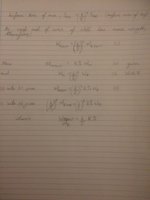student1973
New member
- Joined
- Nov 27, 2020
- Messages
- 5
Hello
I'm new to this site so hopefully I'm asking this question in the right way.
I asked this question online yesterday and received a reply but am not sure I fully understand. This will take a bit of explaining so I will start with the post I gave yesterday:
A man is 6ft tall and his son is a similar solid 5ft tall; they have suits of the same style and cloth. If the weight of the man’s suit is k per cent of his weight, find the weight of the boy’s suit as a percentage of the boy’s weight. (Assume father and son have same density.) What general conclusion can be drawn about the density of cloth suitable for adults and children.
Now, solution gives 6/5 k%, which to me appears to be the ratio of the man’s height to his son’s multiplied by the original percentage of man’s weight. Although I’m sure the author is correct, this doesn’t sit well with me. It doesn’t seem to indicate anything about, for instance, the ratio of volumes of similar figures being the cube of the scale etc. If there is some short cut here that I’m missing then I’m not sure what it is. I would like to know if there is some general rule I’m missing that can derive the correct answer quickly.
I received a prompt and polite reply stating that in essence tis problem was an example of modelling using direct variation, namely that weight of suits is directly proportional to body weights. This is the point I'm struggling with as if this is the case then what is the constant of proportionality? I'm probably not understanding things here but it seems to change from k to 6/5k depending on body weight so how can it be directly proportional? I should also add that this question is from a section of a book involving areas and volumes of similar figures. I would reiterate my point in the previous paragraph regarding the solution being the product of ratio of heights multiplied by k. This indicates, to me at least, that there is some shortcut in answering this problem. However my approach has been to state that the ratio of volumes of man to son is (6/5)^3 and I'm just not sure where in my thought process I'm going wrong.
If anyone can help I would be very grateful.
I'm new to this site so hopefully I'm asking this question in the right way.
I asked this question online yesterday and received a reply but am not sure I fully understand. This will take a bit of explaining so I will start with the post I gave yesterday:
A man is 6ft tall and his son is a similar solid 5ft tall; they have suits of the same style and cloth. If the weight of the man’s suit is k per cent of his weight, find the weight of the boy’s suit as a percentage of the boy’s weight. (Assume father and son have same density.) What general conclusion can be drawn about the density of cloth suitable for adults and children.
Now, solution gives 6/5 k%, which to me appears to be the ratio of the man’s height to his son’s multiplied by the original percentage of man’s weight. Although I’m sure the author is correct, this doesn’t sit well with me. It doesn’t seem to indicate anything about, for instance, the ratio of volumes of similar figures being the cube of the scale etc. If there is some short cut here that I’m missing then I’m not sure what it is. I would like to know if there is some general rule I’m missing that can derive the correct answer quickly.
I received a prompt and polite reply stating that in essence tis problem was an example of modelling using direct variation, namely that weight of suits is directly proportional to body weights. This is the point I'm struggling with as if this is the case then what is the constant of proportionality? I'm probably not understanding things here but it seems to change from k to 6/5k depending on body weight so how can it be directly proportional? I should also add that this question is from a section of a book involving areas and volumes of similar figures. I would reiterate my point in the previous paragraph regarding the solution being the product of ratio of heights multiplied by k. This indicates, to me at least, that there is some shortcut in answering this problem. However my approach has been to state that the ratio of volumes of man to son is (6/5)^3 and I'm just not sure where in my thought process I'm going wrong.
If anyone can help I would be very grateful.

